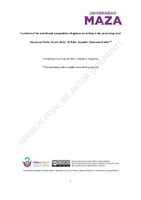Variation of the nutritional composition of quinoa according to the processing used
| dc.contributor.author | Mezzatesta, Pablo | |
| dc.contributor.author | Farah, Silvia | |
| dc.contributor.author | Di Fabio, Amanda | |
| dc.contributor.author | Raimondo, Emilia | |
| dc.date.accessioned | 2020-04-29T15:42:24Z | |
| dc.date.available | 2020-04-29T15:42:24Z | |
| dc.date.issued | 2020 | |
| dc.identifier.citation | Mezzatesta, P.; Farah, S.; Di Fabio, A.; Raimondo, E. (2020) (en prensa). Variation of the nutritional composition of quinoa according to the processing used. Universidad Juan Agustín Maza, Mendoza, República Argentina. | |
| dc.identifier.uri | http://repositorio.umaza.edu.ar/handle/00261/1226 | |
| dc.description.abstract | In Mendoza, Argentina, quinoa is grown with a very good yield, and its consumption is becoming widespread. It is consumed as a seed, flour, expanded, sprout (germinated) and activated (hydrated). The popular belief is that all these forms have the same nutritional contribution. Taking into account this belief, the objective of this work was to determine the nutritional composition of the different preparations. The same batch of quinoa seeds was processed as flour, expanded, hydrated and sprout. It was analyzed by triplicate, applying conventional laboratory techniques. For the statistical analysis, a multiple comparison test was applied, and to discriminate between the means, the honestly significant difference procedure (HSD) of Tukey was applied. It showed that there is statistically significant difference of nutrients between all groups, with a level of 95.0% confidence. For proteins, it varies from 12.78±0.02 g/100g in whole seed to 5.25±0.01 g/100g in the hydrated seed. In total fats, it varies from 7.80±0.02 g/100g in flour to 0.72±0.01 g/100g in sprouts. For fiber, the germinated quinoa provides the highest content (23.50±0.01 g/100g), whereas the hydrated quinoa the lowest content (8.71±0.02 g/100 g). The energy value in 100 g was as follows: whole seed 1299 kcal, flour 1430 kcal, germinated 291 kcal, hydrated 594 kcal and expanded 1368 kcal. This shows how different preparations influence the nutritional contribution of quinoa. With this information, one can recommend different types of preparations depending on the type of nutrient which is wanted for consumption. | es_ES |
| dc.language.iso | eng | es_ES |
| dc.publisher | es_ES | |
| dc.subject | Expanded seed | es_ES |
| dc.subject | Flour | es_ES |
| dc.subject | Germinated seed, | es_ES |
| dc.subject | Hydrated seed | es_ES |
| dc.subject | Quinoa | es_ES |
| dc.title | Variation of the nutritional composition of quinoa according to the processing used | es_ES |
| dc.type | Artículo Científico | es_ES |
| umaza.description.filiation | Fil: Mezzatesta, Pablo. Universidad Juan Agustín Maza. Facultad de Ciencias de la Nutrición; Argentina. | es_ES |
| umaza.description.filiation | Fil: Farah, Silvia. Universidad Juan Agustín Maza. Facultad de Ciencias de la Nutrición; Argentina. | es_ES |
| umaza.description.filiation | Fil: Di Fabio, Amanda. Universidad Juan Agustín Maza. Facultad de Ciencias de la Nutrición; Argentina. | es_ES |
| umaza.description.filiation | Fil: Raimondo, Emilia. Universidad Juan Agustín Maza. Facultad de Ciencias de la Nutrición; Argentina. | es_ES |
| umaza.statusSNRD | Pre-print | es_ES |
Files in this item
This item appears in the following Collection(s)
-
Manuscritos de Ciencias de la Salud Humana [2]
Pre-Prints (manuscritos en versión final de autor para publicación)










